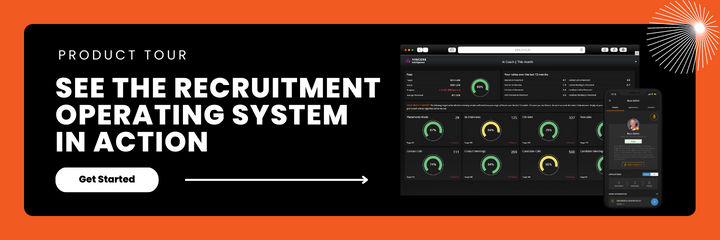Are you looking for a way to revolutionize your recruitment strategies and attract the best talent, no matter where they are? With advances in digital technology and more companies embracing remote work options, now is the perfect time to explore how your organization can leverage alternative recruiting methods to increase your employee pool. Unlocking the power of remote work employment strategies allows you to access a much wider range of highly qualified candidates who may not be within traditional commuting distance.
In this blog post, we'll discuss why it's important for recruiters and beyond to consider taking advantage of these new opportunities as well as tips on how they should go about doing so. Read on to learn more!
Table of Contents
1. What is remote recruiting?
Remote recruiting is the future of hiring, bringing together employers and job seekers in a virtual world of video calls, online assessments, and digital portfolios. It's a futuristic job fair where you can dance in your PJs, demonstrate your skills, and land your dream job, all from the comfort of your own home! Remote recruiting allows you to broaden your horizons and work with companies from all over the world without ever leaving your couch. So, farewell to stuffy office interviews and hello to a fun and exciting future of remote recruiting!
2. Why is remote recruiting important?
Remote recruiting is the cool new kid on the block, and it's taking over the hiring world! Why, might you ask? Let's start with the fact that it opens up a whole new world of opportunities for both businesses and job seekers. You are no longer limited to hiring someone in your town or city. You can find the best talent from anywhere in the world with remote recruiting! That's right, you could be working from the comfort of your own office or home with a team of ninja coders from Japan, creative geniuses from Australia, and tech wizards from Estonia.
Remote recruiting also can help to reduce recruiting costs. When companies don't have to worry about paying for office space or transportation, they can save money. This can be especially helpful during tough economic times when businesses need to reduce costs wherever possible. Say goodbye to long commutes and unnecessary costs!
Finally, remote talent acquisition can help reduce turnover rates and improve employee satisfaction. When employees are able to work from home, they often feel more productive and satisfied with their jobs. This can lead to lower turnover rates and improved morale in the workplace.
And an extra tip: Remote recruiting is essential for businesses pursuing a DEI recruitment strategy.
3. A step-by-step remote recruiting process
If you're not used to recruiting remote workers, the process can seem daunting. How do you find the right candidates? How do you screen them? And how do you make sure they're a good fit for your company? Is your employer's business ready for remote recruitment?
Before recruiters embark on their journey of remote recruitment, they must make sure that their employer's business is ready - that's why we named this step 0. This involvscreees assessing the company's current processes and technologies to ensure that they can support a virtual recruitment process.
Recruiters should also consider whether any additional resources may be needed in order to successfully manage the transition from traditional recruiting methods to remote ones. Furthermore, it is essential for recruiters to communicate with stakeholders about the shift in strategy and gain buy-in from all parties involved.
Here's a detailed guide to recruiting remote workers, broken down into the following easy steps:
Step 1. Define your needs
Before you can start recruiting, you need to define what kind of worker you're looking for. Do you need someone with specific skills or experience? Are you looking for someone to work full-time or part-time? Are there any specific requirements (like location or hours)? Once you've defined your needs, you can start creating a job description. This will help attract the right candidates and give them a better understanding of what the job entails.
Step 2. Source candidates
The best way to find qualified candidates is to source them from online platforms like Indeed, LinkedIn, and UpWork. You can also post ads on social media or job boards. When sourcing candidates, be sure to review their resumes and profiles carefully. Pay attention to their skills and experience, as well as their location and hours of availability.
Step 3. Screen candidates
Once you've sourced a few candidates, it's time to screen them. This involves reviewing their resumes and conducting interviews (either online or in person). During the interview process, be sure to ask questions about their experience and skills, as well as their availability and willingness to work remotely. You should also ask about their communication style and how they handle deadlines.
Step 4. Assess candidates
After screening and interviewing candidates, it's time to assess them. This includes checking references and conducting background checks. Be sure to assess candidates' skills and experience, as well as their cultural fit with your company. It's also important to make sure they're comfortable working remotely and have the necessary tools and resources to do so effectively.
4. Remote recruiting tips
As a remote recruiter, there are a few things you can do to help make your job easier and help attract the best talent. Here are some tips:
Embrace Technology
Make sure you have the right technology and virtual tools in place to support your remote recruiting process. From video conferencing software to virtual assessment tools, technology can help streamline your process and make it more efficient.
Be Clear and Concise
When posting job advertisements, make sure you're clear about the responsibilities, qualifications, and expectations for the role. Be sure to also communicate the benefits of working for your company and what makes your company culture unique.
Get Creative with Interviews
Use virtual interviews to your advantage by making them fun, interactive, and engaging. Consider using tools like screen sharing, gamification, and collaborative notetaking to get a better sense of each candidate's skills and personality.
Focus on Candidate Experience
Remember, the remote recruiting process is a two-way street. Make sure you're doing your part to create a positive experience for candidates, from the moment they apply to the moment they start their new role.
Stay Connected
Communication is key in any recruitment process, but it's especially important in remote recruiting. Make sure you're staying in touch with candidates throughout the process, and be available to answer any questions they may have.
Use social media to spread the word
Social media recruitment is a great way to reach a large number of potential candidates quickly and easily. Make sure you're using all of the social media platforms available to you, and post links to your job descriptions on as many of them as possible.
Stay organized and automatized
This is especially important when you're working with a remote team. Make sure you have a recruitment software system in place for tracking applicants, scheduling interviews, and storing documents. This will help ensure that everything runs smoothly and that everyone is kept up-to-date on the latest developments.
Use video interviews whenever possible
Video interviews can be a great way to get to know candidates without having to meet them in person. They can also help reduce the amount of travel required for interviews. If you can, try to use video interviews as often as possible.
Build your employer's business brand online
Promote your company's remote-friendly ethos too. Use social media platforms and share content that showcases why working remotely can be beneficial for both employees and employers. This will help you attract more remote workers who are looking for a positive and supportive working environment.
Recruiters had better let candidates see the development mindset in them throughout the remote recruiting process. Showcase your team's development values and ensure the candidate sees a clear path for growth within the company. This will help attract the best talent and motivate them to stay with you in the long term.
Crucially, be open-minded. Remote work is often different from traditional office jobs, so don’t expect the job to look exactly the same. Be open to different types of candidates and new approaches to work. This will ensure that you hire the right person for the job, no matter where they’re located.
Finally, be patient. Remote recruiting can take longer than traditional recruitment, so you need to have a little patience while waiting for the right candidate.
5. Conclusion
Remote recruiting has become increasingly popular in recent years, but some companies are still hesitant to jump on board. If you're one of those companies, we hope this post has given you some food for thought and encouraged you to reconsider your stance on remote recruiting. There are a lot of benefits to be had - from increased diversity to lower costs - so it's definitely worth considering!







